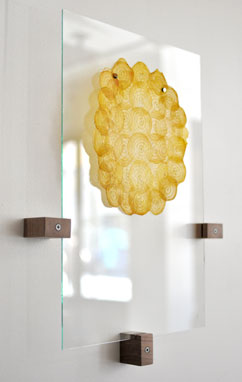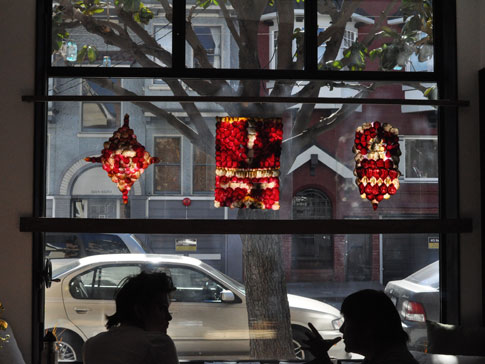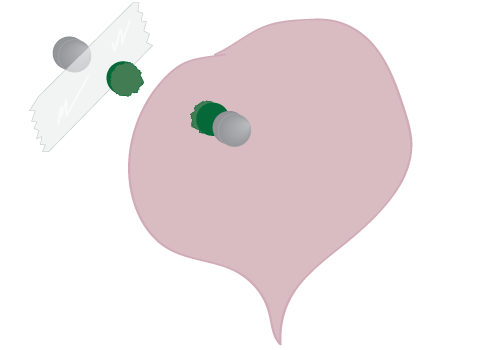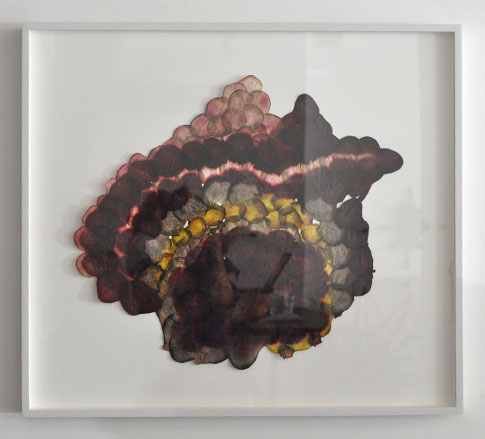Displaying Beet Papyrus
April 24th, 2012 by eleanor - A different kind of warmth TPG20
There are many ways one could display the beet papyrus, but we’ll go over a few of them here:
1. The first option is one that Julia designed herself:
“I don’t want the material behind glass all the time. I want you to be able to experience that material without anything between you and it…. I’ve constructed this wood system so that the glass is off the wall by about an inch and a half. And that allows the beet papyrus to cast a shadow on the wall and it also allows light to come from behind. So that’s kindof the idea: room for shadow, no material or frame between you and the surface, and some natural back-lighting as well.”
We’ve custom built these to Julia’s specs and made them available to purchase through TPG. Go here if you’d like to find out more>>
Advantages: somewhat protected, illuminated from behind by reflection off the wall, ability to look closely at the texture, indirect light, ideal viewing platform designed by the artist
Disadvantages: not really protected from the air, environmental factors, or light
2. A cheaper alternative would be to use 4 1/4″ magnets on a window or wall. The most important thing to note here is that it is not ok to use magnets without a buffer between the magnet and the beet papyrus. An easy way to solve this is to buy some adhesive backed felt dots and stick it to the magnets. If you don’t do this, the magnets will make a hole through the beet papyrus.
Tape the first set of magnets to the window, adhere the felt buffer to both the taped surface of the magnets on the window and to one side of the other magnets. Place the papyrus, and then position the other set of magnets on top.
Advantages: affordable, easy to do, window illumination
Disadvantages: light may damage the papyrus, no protection, not a long-term solution, depending on tape used
3. Professionally framed: float mounted on archival board, with substantial spacer
Advantages: protected from environment and light, easy to hang
Disadvantages: no illumination from behind
13 Comments »
Additional comments powered by BackType















The science behind growing constantly lean, ripped and sustainable muscle, is boosting your physique’s anabolic efficiency, protein synthesis
and delaying fatigue.
In this approach, jewelries won’t be separate, every of them cooperate with each other to type
an eco-system to help folks manage their well-being.
No water or sweet supplied, which is what we all the time
get with the limo service we use in San Jose, CA.
It does not require drilling or tools and needs to be a straightforward return either approach.
And better of all, no waiting.
We have been unable to find a single micathermic heater for sale or anyone who knew what one
was.
“It’s one factor to return home to your condominium being too scorching or too chilly but a complete totally different ballgame to find your private home broken into by hackers with the proper API key!” he says, adding
that his recommendation to individuals who wish to hack their home automation parts is to “ensure to make use of surroundings variables to store delicate credentials relatively than onerous-coding them into your in-progress software.”
Thanks on your information on crazass.
For instance, the website for a Mission Rock neighborhood in Castle Rock,
Colo.
I necessary an adapter to hold my telephone (Samsung Galaxy S II) on a tripod, and this
fits the bill!
If you specify akeystore file, specify the keystore password, the private essential alias, and
the private key password.
Come and join the Houston Museum of Natural Science when Pirates come and
invade Houston. However we might not have thought about it
but our clothes are also related in some way to our heritage.
Read on to learn why.
Right here is the perfect web site for everyone who hopes tto understand this topic.
You understand so much its almost hard to argue with you (not that I really would want to…HaHa).
You certainly put a fresh spin on a subject which has been discussed for years.
Wonderful stuff, just great!
Why people still use to read news papers
when in this technological globe all is accessible on web?